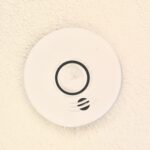 It’s mid-October and it’s time to think about Smoke Alarm ITM. “What’s that,” you ask?
It’s mid-October and it’s time to think about Smoke Alarm ITM. “What’s that,” you ask?
The National Fire Prevention Association (NFPA) reminds us every year that smoke alarm inspection, testing and maintenance (ITM) are the responsibility of every homeowner, as well as those owning or managing rental units and commercial properties. Fire fighters will tell you nothing is more tragic than the loss of life in the fall or winter due to a candle lit fire and nonworking smoke alarms.
The NFPA knows what it’s talking about. As a 100-year old national organization, it is the nonprofit, nonpartisan organization that investigates fire incidents and sets national standards for fire safety. It is the go-to-source for fire prevention, fire fighters and building and safety professionals. Many of its standards are de facto building code standards for fire safety for home construction, public facilities and all types of commercial establishments, businesses and industrial factories or plants.
 Standalone home smoke alarm batteries typically last only a year—perhaps less during especially hot summers or if they have gone off multiple times. Both the batteries and the actual smoke sensors wear out too. In fact, depending on the manufacturer’s product manual, you will also likely need to test the sensor every year and eventually change the sensor or purchase a new unit every few years. Be sure to check your smoke alarm owner’s manual.
Standalone home smoke alarm batteries typically last only a year—perhaps less during especially hot summers or if they have gone off multiple times. Both the batteries and the actual smoke sensors wear out too. In fact, depending on the manufacturer’s product manual, you will also likely need to test the sensor every year and eventually change the sensor or purchase a new unit every few years. Be sure to check your smoke alarm owner’s manual.
 The batteries, however, are an annual must-do maintenance item to mark in red on your calendar. The fall season is a good time to change out alarm batteries because the holidays are right around the corner, which brings the lighting of scented room candles, religious celebration candles or romantic dinner table taper candles. As the temperature cools more, you might also want to build a cozy wood fire with embers that glow long after you’ve gone to bed.
The batteries, however, are an annual must-do maintenance item to mark in red on your calendar. The fall season is a good time to change out alarm batteries because the holidays are right around the corner, which brings the lighting of scented room candles, religious celebration candles or romantic dinner table taper candles. As the temperature cools more, you might also want to build a cozy wood fire with embers that glow long after you’ve gone to bed.
 In addition, many people are now using aroma therapy candles to relax near bath tubs or on night stands or in meditation spaces. Open flames are always a risk—especially if your relaxation time is interrupted by an unexpected phone call or the kids being kids or a neighbor ringing the doorbell. Accidental fires can start quickly from unsupervised candles as the breeze from an open window blows your curtains or a shade over the flame or that lovable curious cat tips a candle over.
In addition, many people are now using aroma therapy candles to relax near bath tubs or on night stands or in meditation spaces. Open flames are always a risk—especially if your relaxation time is interrupted by an unexpected phone call or the kids being kids or a neighbor ringing the doorbell. Accidental fires can start quickly from unsupervised candles as the breeze from an open window blows your curtains or a shade over the flame or that lovable curious cat tips a candle over.
At Helfrich Associates, we don’t perform smoke alarm maintenance. We have, however, frequently been called in by homeowners and their insurance companies to review fire damage to homes and businesses. We also have helped homeowners with numerous custom build and large home expansion or renovation projects that require the installation of smoke alarms.
As licensed professional structural engineers, we understand the importance of keeping you safe day and night in your home. It would be easy for us to tell you that candles and wood fires are a safety “no-no,” but even we enjoy them. Just please be careful with them. In addition, there are many other fire hazards in homes that can be invisible, such as animal damage to wiring behind the walls or crowded power strips with too many phones, pads, gaming and other personal electronics.
So even if you’re now a confirmed battery candle devotee or an electric or natural gas fire place owner. you still need smoke alarms in your home. They’re required by law in new homes and anytime a home ownership sale or transfer occurs. Even if your home in California is a century old classic, the home inspector will be looking for the smoke and gas alarms as a condition of sale. They also have to be in good working order (functional batteries, working sensors and horns) to pass the inspection.
At Helfrich Associations, we understand what’s at stake–the health and safety of you and your family. So please check your file drawer or homeowners manual binder or wherever you keep important house papers for that smoke alarm manual. If you can’t easily find it, look it up on the Internet because the manufacturers keep an archive of smoke alarm manuals for homeowners to download.
Smoke alarm ITM can be a relatively easy and satisfying DIY project if you’re barely handy and in good enough physical health to climb a ladder with a couple of simple tools. If you’re in poor health or not handy at all, call a handy helper service. Be sure to have the required battery type before your service technician arrives—check the manual for the proper battery type.
You can do this, get it all done and then sit back, relax and enjoy the glow of the evening. Your holiday season will be ever so less stressful once the smoke alarm batteries are changed and the sensor has been checked. In fact, you’re good for another year to do whatever you please safe and snug at home.
